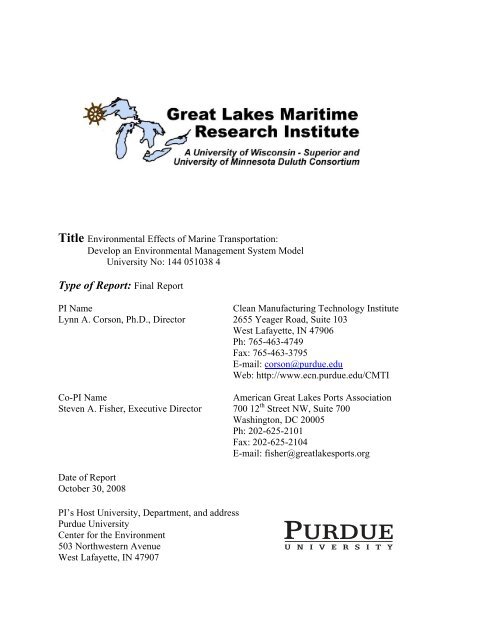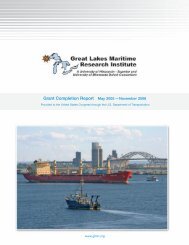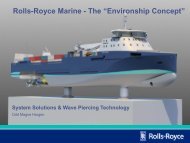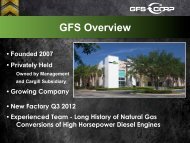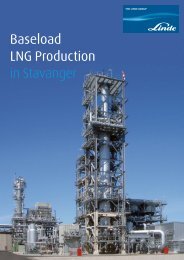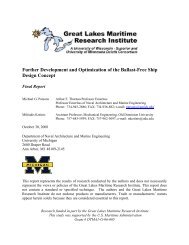Environmental Effects of Marine Transportation - Great Lakes ...
Environmental Effects of Marine Transportation - Great Lakes ...
Environmental Effects of Marine Transportation - Great Lakes ...
You also want an ePaper? Increase the reach of your titles
YUMPU automatically turns print PDFs into web optimized ePapers that Google loves.
Title <strong>Environmental</strong> <strong>Effects</strong> <strong>of</strong> <strong>Marine</strong> <strong>Transportation</strong>:Develop an <strong>Environmental</strong> Management System ModelUniversity No: 144 051038 4Type <strong>of</strong> Report: Final ReportPI NameClean Manufacturing Technology InstituteLynn A. Corson, Ph.D., Director 2655 Yeager Road, Suite 103West Lafayette, IN 47906Ph: 765-463-4749Fax: 765-463-3795E-mail: corson@purdue.eduWeb: http://www.ecn.purdue.edu/CMTICo-PI NameAmerican <strong>Great</strong> <strong>Lakes</strong> Ports AssociationSteven A. Fisher, Executive Director 700 12 th Street NW, Suite 700Washington, DC 20005Ph: 202-625-2101Fax: 202-625-2104E-mail: fisher@greatlakesports.orgDate <strong>of</strong> ReportOctober 30, 2008PI’s Host University, Department, and addressPurdue UniversityCenter for the Environment503 Northwestern AvenueWest Lafayette, IN 47907
This report represents the results <strong>of</strong> research conducted by the authors and does not necessarilyrepresent the views or policies <strong>of</strong> the <strong>Great</strong> <strong>Lakes</strong> Maritime Research Institute. This report doesnot contain a standard or specified technique. The authors and the <strong>Great</strong> <strong>Lakes</strong> MaritimeResearch Institute do not endorse products or manufacturers. Trade or manufacturers’ namesappear herein solely because they are considered essential to this report.Research funded in part by the <strong>Great</strong> <strong>Lakes</strong> Maritime Research Institute.This study was supported by the U.S. Maritime AdministrationGrant # DTMA1-G-06-005
Executive SummaryThe American <strong>Great</strong> <strong>Lakes</strong> Ports Association partnered with the Clean ManufacturingTechnology Institute (CMTI) at Purdue University in West Lafayette, Indiana to examine theenvironmental management aspects <strong>of</strong> port operations, including the oversight <strong>of</strong> tenantoperations that could negatively impact the environment.The research was conducted via two-day site visits to twelve American and Canadianports and interviews with port and tenant personnel, tours <strong>of</strong> port/tenant facilities and internetand other document research.The research and the analysis <strong>of</strong> operations at the twelve ports revealed:• The form <strong>of</strong> governance (municipal unit, independent public authority, state/federalchartered) may influence the oversight <strong>of</strong> tenant operations;• In some cases, the provisions <strong>of</strong> port lease agreements with tenants pertaining toenvironmental protection could be strengthened;• The issuance <strong>of</strong> environmental permits to ports and their tenants are not uniform among thestates/provinces;• Ports would benefit from developing a “master” plan for controlling stormwater run-<strong>of</strong>f andresponding to spills/releases <strong>of</strong> hazardous materials, both <strong>of</strong> which are regulated activities;• Ports have engaged in environmental projects <strong>of</strong> various types, individually and withpartners, affecting their property and neighboring property;• Community outreach programs to engage, involve and respond to the public varyconsiderably among the ports.The research has produced an environmental management system “model” for adoption bysmall, public ports and a manual <strong>of</strong> best management practices to prevent or reduce negativeimpacts on the environment from port and tenant operations.The major operations analyzed included:• Dry bulk storage and handling• Liquid Bulk storage and transfer (loading/unloading)• Non-bulk chemical storage and handling• Port cargo handling equipment and rail/truck operations powered by diesel engines• Vehicle and equipment fueling• Port authority oversight <strong>of</strong> tenant activities through lease agreements• Management <strong>of</strong> hazardous and non-hazardous waste generated by port/tenant activities• General operations that can impact neighboring areas: noise, light, odor, trash, dust• Building and grounds maintenanceEach operation was analyzed in terms <strong>of</strong> its potential environmental impacts to air, water,groundwater and land. Over 180 best management practices (BMPs) are recommended for thenine operations; 40 regulatory citations supporting the BMPs are included and 40 sources(references) <strong>of</strong> information are provided to assist the ports/tenants with implementation <strong>of</strong> therecommended BMPs.
The “model” <strong>Environmental</strong> Management System (EMS) produced by the project used theISO 14001: 2004 <strong>Environmental</strong> Management System Standard as the guide. All 17 elements <strong>of</strong>the Standard are included and tailored to port operations. An abbreviated EMS form was alsoprepared: the <strong>Environmental</strong> Management Program form allows port authority personnel toorganize and manage their port operations with consideration given to the environment in whichthose operations occur.The relationship between the port/tenant operations and the BMPs pertinent to those operationsis strengthened by inclusion <strong>of</strong> both in the port’s EMS. The Best Management Practices Manualproduced by the project can be used by ports seeking to implement operational controls (BMPs) toreduce the actual or potential environmental impacts resulting from an aspect <strong>of</strong> a port operation.
IntroductionAs a component <strong>of</strong> the <strong>Great</strong> <strong>Lakes</strong>-St. Lawrence Seaway Maritime Industry’s “Green<strong>Marine</strong>” initiative, the American <strong>Great</strong> <strong>Lakes</strong> Ports Association (AGLPA) approached PurdueUniversity (CMTI) in 2006 to assist them in developing a project to: 1) survey environmentalpractices at <strong>Great</strong> <strong>Lakes</strong> ports, 2) compile a catalogue <strong>of</strong> best management practices for portoperations, and 3) develop a simplified <strong>Environmental</strong> Management System tool that would helpsmall port entities improve environmental performance.Developed jointly by Purdue-CMTI in partnership with AGLPA, the project evaluatedtwelve U.S. and Canadian ports with regard to a host <strong>of</strong> environmental issues. The goal was toidentify areas <strong>of</strong> opportunity at <strong>Great</strong> <strong>Lakes</strong> ports for environmental improvement. Perhaps <strong>of</strong>greatest use, the project developed a manual <strong>of</strong> best practices that will assist small ports infinding ways to manage environmental issues within limited budget and staff resources.As the owners and stewards <strong>of</strong> considerable tracts <strong>of</strong> land in many <strong>Great</strong> <strong>Lakes</strong> cities, theports are eager to address any environmental liabilities and, also, to identify opportunities forpossible new restoration projects.1
BackgroundThe research project was conducted in two phases. The objective <strong>of</strong> the first phase <strong>of</strong> theproject was to develop an environmental survey tool using information gathered from a series <strong>of</strong>two-day site visits at four <strong>Great</strong> <strong>Lakes</strong> ports. After receiving approval <strong>of</strong> representatives <strong>of</strong> theAmerican <strong>Great</strong> <strong>Lakes</strong> Ports Association, project staff proceeded to use the tool for subsequentsurveys, in the second phase <strong>of</strong> the project, at eight other American and Canadian <strong>Great</strong> <strong>Lakes</strong>Ports.The aspects <strong>of</strong> the survey tool that comprised the focus <strong>of</strong> the site visits include:• The form <strong>of</strong> governance <strong>of</strong> the port authority (e.g., independent public authority, unit <strong>of</strong>local government or state or federal chartered) and its influence on a port’s oversight <strong>of</strong>environmental management;• The legal (e.g., lease) and other forms <strong>of</strong> agreement between the port authority and itstenants governing tenant operations and the potential environmental impacts <strong>of</strong> suchoperations;• The compliance and permit status <strong>of</strong> the port authority and its tenants, pursuant to local,state or provincial, and federal environmental regulations;• The adequacy <strong>of</strong> the infrastructure and protective measures provided by the port authorityfor its tenants or by its tenants (especially those with “bare ground” leases) to preventspills/releases <strong>of</strong> hazardous or potentially hazardous materials (e.g., salt, fertilizer,cement, petroleum products) that could contaminate port authority property and/orwaterways;• The relationship between the port authority and its tenants for clean-up and/orremediation <strong>of</strong> property contaminated by spills/releases <strong>of</strong> hazardous materials;• The relationship between the port authority and rail lines and trucking companies servingthe port authority and its tenants, as it pertains to environmental protection;• The relationship between the port authority and neighboring private propertyowners/operators using common port facilities and waterways, as it pertains toenvironmental protection;• Review <strong>of</strong> past and recent environmental accomplishments (e.g., wetlands restoration,brownfield redevelopment) and community outreach programs pertaining toenvironmental matters.Each <strong>of</strong> these will be examined in the remainder <strong>of</strong> this report.2
Research ApproachThe research project involved a series <strong>of</strong> two-day site visits to twelve <strong>Great</strong> <strong>Lakes</strong> ports.The visits included interviews with port directors and other administrative staff, staff orconsultants responsible for environmental matters, management staff at tenant operations, localplanning <strong>of</strong>ficials, economic development <strong>of</strong>ficials and other government representatives and adriving and walking tour <strong>of</strong> port and neighboring property, including tenant operations.Documents, including those provided by port personnel as well as annual reports andmarketing brochures collected during the visit were reviewed. The environmental regulatorycompliance and permit status <strong>of</strong> each port and its tenants was accessed via federal and state orprovincial websites providing such information prior to the visits.The Port <strong>Environmental</strong> Survey Form (Appendix A) was used to guide the interviews andthe tours and record the information for the subsequent preparation <strong>of</strong> the port report.3
Findings and AnalysisGovernanceThe ports visited differ markedly in governance and environmental management and theform <strong>of</strong> governance (e.g., independent public authority, unit <strong>of</strong> local government, state or federalchartered entity) appears to influence, but not totally determine, a port’s authority andpredisposition to exercise oversight <strong>of</strong>, for example, the operations <strong>of</strong> tenants that could have anegative impact on the environment. The resources available to the port - - staff, consultants andbudget - - also influence the priority given to environmental management <strong>of</strong> port and tenantoperations.Tenant Lease AgreementsOne obvious way <strong>of</strong> attempting to influence tenant operations, vis-à-vis environmentalprotection, is through the lease agreement <strong>of</strong>fered by the port.A review <strong>of</strong> lease agreements for the ports visited revealed a variety <strong>of</strong> provisions pertainingto tenant environmental responsibilities:• Tenant must comply with all federal, state and municipal environmental laws,regulations, ordinances; agree to use the site consistent with its intended use; responsiblefor obtaining environmental permits;• Tenant must comply with all environmental laws and regulations; indemnify port withrespect to claims, orders, actions regarding pollutants or toxic substances; responsible forclean-up and solely responsible for damages;• Tenant must comply with all local, state and federal laws and regulations; indemnify theport; provide notices <strong>of</strong> non-compliance; pay all costs associated with spills, clean-up andremediation <strong>of</strong> leased property (even if not required by a government agency); annuallyprovide copy <strong>of</strong> emergency preparedness and response plan; annually provide list <strong>of</strong>hazardous materials; seek approval <strong>of</strong> the port to install USTs (Underground StorageTanks); allow port to inspect the property and conduct environmental audits and siteassessments, including at the termination <strong>of</strong> the lease; extend lease provisions to sublessee.The range <strong>of</strong> provisions, from basic “boilerplate” to comprehensive oversight <strong>of</strong> tenantoperations that could impact the environment, could reflect the port’s form <strong>of</strong> governance andthe environmental knowledge <strong>of</strong> the attorney who drafted the lease more than the managementprerogative <strong>of</strong> the port authority or its administration. It is also apparent that the “landlord-tenantrelationship” is crucial to achievement <strong>of</strong> the economic development goals <strong>of</strong> the port. Portmanagement made it clear that they were not regulators and that other agencies <strong>of</strong> state,municipal and federal government had that role.4
Tenant and Port Regulatory Compliance and Permit StatusCompliance inspections by state/provincial and federal agencies are and should be madeand most <strong>of</strong> those interviewed thought regulatory oversight to be reasonable and useful.With regard to permitting, some <strong>of</strong> the findings include:• Air permits are most prevalent among tenants, followed by hazardous waste (RCRA) andwater discharge (NPDES); Confined Disposal Facility permits for dredged material ismost common among ports;• Compliance enforcement by government authorities is not uniform and some tenantfacilities that are not permitted should be;• Larger tenants with regional or nationwide operations appear to be in full compliance;• Control <strong>of</strong> fugitive dust from access roads and bulk product storage and handling is achallenge to ports and tenants, alike;• Diesel emissions from ships, cranes, other heavy equipment, trains and trucks is notperceived as a problem, but is not uniformly monitored by government agencies.<strong>Environmental</strong> compliance <strong>of</strong> the port authority, its tenants and adjacent non-tenant marineoperators appear to be influenced by a combination <strong>of</strong>: management resources, communityinterest, local, state and federal regulatory oversight and corporate oversight.Preventing/Controlling Stormwater Run-<strong>of</strong>f and Hazardous Materials SpillsThe water-side location <strong>of</strong> ports and most tenants poses a more significant environmentalconcern than for facilities located inland, especially with regard to stormwater run-<strong>of</strong>f andhazardous materials spills.Below are some <strong>of</strong> the findings from the port visits:• Stormwater run-<strong>of</strong>f from bulk storage piles, bulk tank secondary containment structures,piers and dredge areas is being addressed at some locations by the installation <strong>of</strong>infrastructure modifications (e.g., detention ponds, stormwater drains, catch basins, lowpr<strong>of</strong>ileberms at the edge <strong>of</strong> piers, sloping the edge <strong>of</strong> piers away from the water);however, protections appear to be inconsistent depending on the age <strong>of</strong> the facility, thejurisdiction (state/province), and the type <strong>of</strong> cargo-handling activity taking place;• At U.S. ports, liquid bulk tank farms and fueling facilities have federally-required SpillPrevention Control and Countermeasure (SPCC) Plans;• Ports would benefit from efforts to develop a “master” environmental response planaddressing releases from the transfer, movement and storage <strong>of</strong> materials at or by tenantfacilities, ship owners, rail lines, truck lines and adjacent property owners;• Not all port authorities are on the “call list” or require “first call” status when a spilloccurs on its property occupied by a tenant;• Individual tenants or transporters may have a plan or procedures that exist independent <strong>of</strong>others;5
• Emergency response organizations are either the local fire department or a contract spillresponse organization -- some <strong>of</strong> the latter are tenants <strong>of</strong> the port;• With regard to spills in navigable waters, in some locations the Coast Guard is notconsidered a “first responder” organization;• In general, spill response procedures seemed to differ by location, depending uponmunicipal and state/provincial requirements. Spill response notification procedures werenot always commonly understood;• In the U.S., stormwater regulations applicable to municipal and other public facilitieswere promulgated in 1999 and some <strong>Great</strong> <strong>Lakes</strong> states are only now issuing permits, soregulatory compliance and enforcement is generally lacking. Also, stormwater run-<strong>of</strong>fdoesn’t have the same visibility or receive the same public scrutiny as air emissions andhazardous waste generation because <strong>of</strong> the general perception that it’s a naturalconsequence <strong>of</strong> precipitation -- in other words, “it’s always been there.”The Spill Prevention, Control and Countermeasure (SPCC) Plan required by the U.S.<strong>Environmental</strong> Protection Agency incorporates requirements that apply not only to petroleumproduction and petroleum storage operations, but to port operations, such as the transfer <strong>of</strong>petroleum and chemical products from vessels to storage tanks, trucks and rail tankers.Some U.S. port operations and many tenant operations are subject to these rules and some <strong>of</strong>both groups have SPCC plans and conduct drills to “practice the plan,” but more <strong>of</strong> both groupsneed to.Past and Recent <strong>Environmental</strong> Program AccomplishmentsIt is apparent that ports are aware <strong>of</strong> the environment in which they are located. Theirintroduction to environmental concerns has usually been a result <strong>of</strong> community input or largeprojects such as contaminated sediment remediation, brownfield redevelopment, management <strong>of</strong>dredge material disposal, etc.Ports have engaged in cooperative environmental projects with neighbors to restorewetlands; other ports have initiated marine recreation improvements (e.g., marinas), improvedfish habitat and restored shorelines, some with walking trails for the recreating public.The community outreach programs vary among the ports visited. Some ports haveadopted a policy <strong>of</strong> inclusivity and may regularly meet with citizen groups, organize advisorycommittees, include representation on their governing board, establish a “hotline” for the publicto report perceived environmental problems and other such measures. Other ports may only postthe schedule <strong>of</strong> their Board or Commission meetings in the local newspaper, pursuant to publicnotification requirements.6
Potential Economic Impacts <strong>of</strong> the Research ResultsFor large port businesses incorporating transportation, processing, storage, manufacturingand similar operations, many <strong>of</strong> which involve hazardous and polluting materials, theenvironmental impacts <strong>of</strong> incidents due to improper or inadequate management can beconsiderable, especially because <strong>of</strong> their location on the <strong>Great</strong> <strong>Lakes</strong>.There are no environmental impacts -- negative or positive -- in the port or any other businesssector that are not directly or indirectly linked to economic impacts. One port manager statedthat “what is good for the environment is good for business.”The outcomes <strong>of</strong> this research, included below, need to be viewed from both theenvironmental and economics perspective:• An increased awareness by port directors and staff as to the potential impact <strong>of</strong> their andtheir tenants’ operations on the environment;• An increased understanding <strong>of</strong> the role/responsibility <strong>of</strong> a port authority for theoperations <strong>of</strong> its tenants that could impact the environment;• Possible changes in the policies, procedures and practices employed by port authoritiesfor improved management <strong>of</strong> port property and oversight <strong>of</strong> tenant operations;• Most public ports surveyed operate as “landlord” ports -- leasing publicly-owned land tocommercial businesses. The role <strong>of</strong> these ports -- as an engine <strong>of</strong> economic development-- is critical to the local economy and their success could be adversely affected if theyadopted a quasi-regulatory role with respect to the oversight <strong>of</strong> tenant and lesseeactivities that have the potential to impact the environment. Consequently, the role <strong>of</strong>state/provincial regulatory <strong>of</strong>ficials remains critical.7
(Page intentionally blank)
Appendix APort <strong>Environmental</strong> Survey Form
(Page intentionally blank)
Port <strong>Environmental</strong> Survey: ______________________________________(Name <strong>of</strong> Port)Date <strong>of</strong> Site Visit: _______________ Survey Team Member: ___________________1. General Informationa. Description <strong>of</strong> port governance structure, staff, resources, budget:b. Physical configuration <strong>of</strong> the port:c. Types and tonnage <strong>of</strong> cargo handled at the port:d. Number <strong>of</strong> facilities and acres within the port authority’s jurisdiction:e. Number <strong>of</strong> facilities and acres adjacent to the port authority’s jurisdiction:2. Names <strong>of</strong> Lessees Activity/Product Building/or Outside Area(*If bare ground)3. Port Land Use (General Observations)a. Drums, tanks (including AST or UST) or other containers used for chemical or petroleumstorage:b. Pits, ponds or lagoons for storage or treatment <strong>of</strong> wastewater or stormwater:c. Standing pools <strong>of</strong> water or wet areas not caused by weather conditions:d. Stained soil or pavement or dead or stressed vegetation:e. Random accumulation/storage <strong>of</strong> solid waste material (including recyclables):f. Transformers, capacitors or hydraulic equipment which may contain PCBs:I. Stormwater run<strong>of</strong>f (with materials migration) from outsidedry bulk storage areas:h. Secondary containment <strong>of</strong> liquid bulk storage tanks:A-1
i. Wastewater discharged to a treatment plant within or outside port property:j. Sensitive environmental resource (e.g., wetland) proximate to port-owned land:k. Dredge material disposal/use:l. Operations/activities that are obvious sources <strong>of</strong> air emissions (e.g., diesel, dust):- tenants- trucks, trains, ships entering and operating on port property- truck, fork lifts, cranes and other port or tenant-owned equipment4. Port Spill Response Operationsa. Material handling operations, such as dry and liquid bulk on-loading/<strong>of</strong>f-loading andstorage, are performed according to procedures that prevent migration <strong>of</strong> material orspills/releases to waterway:b. The port authority and the rail lines and trucking companies serving the port have anagreement regarding response to and responsibility for spills and releases:c. The port authority and neighboring private property owners have an agreement regardingresponse to and responsibility for spills and releases:d. The port authority and its tenants have an agreement regarding response to andresponsibility for spills and releases:e. The port authority and ship owners serviced by the port have an agreement regardingresponse to and responsibility for spills and releases:5. Port <strong>Environmental</strong> Managementa. Provisions <strong>of</strong> existing environmental policy:b. Designation <strong>of</strong> staff with responsibility for environmental matters and description <strong>of</strong>tasks in pertinent job description(s):c. Existence <strong>of</strong> a reporting system for environmental incidents: type <strong>of</strong> incidents recorded;fines paid; legal issues pending:A-2
d. Estimated annual expenditures for environmental protection: personnel and non-personalcategories:e. Estimated annual research and development expenditures for environmental protectionimprovements:f. Description <strong>of</strong> environmental training programs for employees:g. Description <strong>of</strong> community outreach programs pertaining to environmental matters:h. Description <strong>of</strong> how landlord ports work with tenants on environmental issues:i. Provisions <strong>of</strong> lease agreements or other instruments with tenants governingenvironmental matters:j. Description <strong>of</strong> the major environmental liabilities at each port area:a. on port authority landb. on land adjacent to the port authorityk. Description <strong>of</strong> the major environmental successes at each port:a. as a result <strong>of</strong> port authority actionb. as a result <strong>of</strong> the action <strong>of</strong> othersl. Description <strong>of</strong> “brownfields” or other reclamation on port authority land:m. Description <strong>of</strong> any port authority interaction with local government planning <strong>of</strong>ficials:6. Compliance and Permit Status <strong>of</strong> the Port Authority and its Tenants:(Remainder <strong>of</strong> page intentionally left blank)A-3


